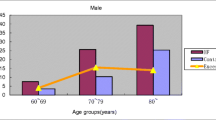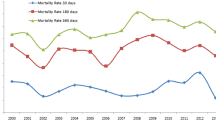Abstract
Summary
This study aimed to determine factors affecting the survival of patients with hip fracture in Shiraz, Iran. Alzheimer’s disease, hypertension, and cardiovascular diseases were risk factors, while female gender and living with family members or in nursing homes were protective factors against mortality following hip fracture.
Purpose
Hip fractures are the most common orthopedic fractures in elderly. This study aimed to determine the factors affecting the survival of patients with hip fracture in Shiraz.
Methods
This historical cohort study was conducted in Shiraz, Iran. All patients with hip fracture who were admitted to any of the hospitals providing orthopedic services in Shiraz, from September 1, 2011, to August 30, 2012, were included in the study. The log rank test, Kaplan–Meier methods, and the univariate and multivariate Cox regression model were used for data analysis.
Results
A total of 631 patients were enrolled, of these, 264 (41.8%) were male. The mean age of patients was 74.9 ± 11.5. The patients’ survival rate after the 1st, 2nd, 3rd, 4th, and 5th year were 81.1%, 73.7%, 69.4%, 64.8%, and 60.2%, respectively. After adjusting data for age, Alzheimer’s disease (HR = 4.9, 95% CI 1.4–7.3, P = 0.023), hypertension (HR = 2.27, 95% CI 1.3–3.8, P = 0.003), and cardiovascular diseases (HR = 2.02, 95% CI 1.04–3.09, P = 0.039) remained as risk factors for mortality in patients with hip fracture. However, female patients (HR = 0.46, 95% CI 0.27–0.8, P = 0.006) and those who lived with family members or in nursing homes (HR = 0.43, 95% CI 0.19–0.92, P = 0.03) were protective factors.
Conclusion
This study showed that women are more likely to have hip fractures, but mortality among men is more observable. Alzheimer’s disease, hypertension, and cardiovascular diseases were considered as risk factors, while patients who were female and those who lived with the family member or in nursing homes had better survival.


Similar content being viewed by others
References
Lehtonen, E.J.I., et al., Trends in surgical treatment of femoral neck fractures in the elderly. Einstein (Sao Paulo, Brazil), 2018. 16(3): p. eAO4351-eAO4351
Dhanwal DK, Dennison EM, Harvey NC, Cooper C (2011) Epidemiology of hip fracture: worldwide geographic variation. Indian journal of orthopaedics 45(1):15–22
Sullivan KJ et al (2016) Demographic factors in hip fracture incidence and mortality rates in California, 2000-2011. J Orthop Surg Res 11:4–4
Carpintero P, Caeiro JR, Carpintero R, Morales A, Silva S, Mesa M (2014) Complications of hip fractures: a review. World journal of orthopedics 5(4):402–411
Banks E, Reeves GK, Beral V, Balkwill A, Liu B, Roddam A, Million Women Study Collaborators (2009) Hip fracture incidence in relation to age, menopausal status, and age at menopause: prospective analysis. PLoS Med 6(11):e1000181–e1000181
Li S, Dai Z, Wu Q (2015) Effect of coffee intake on hip fracture: a meta-analysis of prospective cohort studies. Nutr J 14:38–38
Hoidrup S et al (2000) Tobacco smoking and risk of hip fracture in men and women. Int J Epidemiol 29(2):253–259
Kim BH, Lee S, Yoo B, Lee WY, Lim Y, Kim MC, Yon JH, Kim KM (2015) Risk factors associated with outcomes of hip fracture surgery in elderly patients. Korean journal of anesthesiology 68(6):561–567
Marley WD, Kelly G, Thompson NW (2015) Alcohol-related fracture admissions: a retrospective observational study. The Ulster medical journal 84(2):94–97
Leung F et al (2010) Does timing of surgery matter in fragility hip fractures? Osteoporosis international : a journal established as result of cooperation between the European Foundation for Osteoporosis and the National Osteoporosis Foundation of the USA 21(Suppl 4):S529–S534
Mears SC, Kates SL (2015) A guide to improving the care of patients with fragility fractures, edition 2. Geriatric orthopaedic surgery & rehabilitation 6(2):58–120
Bukata SV, Digiovanni BF, Friedman SM, Hoyen H, Kates A, Kates SL, Mears SC, Mendelson DA, Serna FH Jr, Sieber FE, Tyler WK (2011) A guide to improving the care of patients with fragility fractures. Geriatric orthopaedic surgery & rehabilitation 2(1):5–37
Nasab SAM, Khorramdin E (2017) The assessment of mortality and quality of life after intertrochanteric fracture of femur in patients older than 60 at Emam Khomeini Hospital of Ahvaz. Pakistan journal of medical sciences 33(4):895–898
Magaziner J, Chiles N, Orwig D (2015) Recovery after hip fracture: interventions and their timing to address deficits and desired outcomes--evidence from the Baltimore hip studies. Nestle Nutrition Institute workshop series 83:71–81
Riemen AHK, Hutchison JD (2016) The multidisciplinary management of hip fractures in older patients. Orthopaedics and trauma 30(2):117–122
Beaupre, L.A., Binder E.F., Cameron I.D., Jones C.A., Orwig D., Sherrington C., Magaziner J., Maximising functional recovery following hip fracture in frail seniors. Best practice & research. Clin Rheumatol, 2013. 27(6): p. 771–788
Colón-Emeric CS (2012) Postoperative management of hip fractures: interventions associated with improved outcomes. BoneKEy reports 1:241–241
Choi HJ, Kim E, Shin YJ, Choi BY, Kim YH, Lim TH (2014) The timing of surgery and mortality in elderly hip fractures: a retrospective, multicenteric cohort study. Indian journal of orthopaedics 48(6):599–604
Streubel PN et al (2011) Mortality after distal femur fractures in elderly patients. Clin Orthop Relat Res 469(4):1188–1196
Keene GS, Parker MJ, Pryor GA (1993) Mortality and morbidity after hip fractures. Bmj 307(6914):1248–1250
Baudoin, C., et al., Clinical outcomes and mortality after hip fracture: a 2-year follow-up study. Bone, 1996. 18(3 Suppl): p. 149s–157s
Rahnavard Z et al (2009) The incidence of osteoporotic hip fracture: Iranian multicenter osteoporosis study (IMOS). Res j Biol sci 4(2):171–173
Yeganeh A, Khatami F, Abolghasemian M (2014) Mortality rate in the first year after hip fracture in 65 year old or older patients in Rasool Akram hospital (Tehran). Babol-Jbums 16(1):112–116
Rath S, Yadav L, Tewari A, Chantler T, Woodward M, Kotwal P, Jain A, Dey A, Garg B, Malhotra R, Goel A, Farooque K, Sharma V, Webster P, Norton R (2017) Management of older adults with hip fractures in India: a mixed methods study of current practice, barriers and facilitators, with recommendations to improve care pathways. Arch Osteoporos 12(1):55–55
Rozell, J.C., et al., Recent advances in the treatment of hip fractures in the elderly. F1000Research, 2016. 5: p. F1000 Faculty Rev-1953
Teng GG, Curtis JR, Saag KG (2008) Mortality and osteoporotic fractures: is the link causal, and is it modifiable? Clin Exp Rheumatol 26(5 Suppl 51):S125–S137
Alexiou KI, Roushias A, Varitimidis SE, Malizos KN (2018) Quality of life and psychological consequences in elderly patients after a hip fracture: a review. Clin Interv Aging 13:143–150
Guerra MTE et al (2016) One-year mortality of elderly patients with hip fracture surgically treated at a hospital in Southern Brazil. Rev Bras Ortop 52(1):17–23
Kilci, O., et al., Postoperative mortality after hip fracture surgery: a 3 years follow up. PLoS One, 2016. 11(10)
Lee AYJ et al (2012) Five-year outcome of individuals with hip fracture admitted to a Singapore Hospital: quality of life and survival rates after treatment. J Am Geriatr Soc 60(5):994–996
Sheikh HQ, Hossain FS, Aqil A, Akinbamijo B, Mushtaq V, Kapoor H (2017) A comprehensive analysis of the causes and predictors of 30-day mortality following hip fracture surgery. Clinics in orthopedic surgery 9(1):10–18
Franco LG, Kindermann AL, Tramujas L, de Souza Kock K (2016) Factors associated with mortality among elderly people hospitalized due to femoral fractures. Rev Bras Ortop 51(5):509–514
Oh ES, Sieber FE, Leoutsakos JM, Inouye SK, Lee HB (2016) Sex differences in hip fracture surgery: preoperative risk factors for delirium and postoperative outcomes. J Am Geriatr Soc 64(8):1616–1621
Kannegaard PN, van der Mark S, Eiken P, Abrahamsen B (2010) Excess mortality in men compared with women following a hip fracture. National analysis of comedications, comorbidity and survival. Age Ageing 39(2):203–209
Panula J et al (2011) Mortality and cause of death in hip fracture patients aged 65 or older: a population-based study. BMC Musculoskelet Disord 12:105–105
Chang W, Lv H, Feng C, Yuwen P, Wei N, Chen W, Zhang Y (2018) Preventable risk factors of mortality after hip fracture surgery: systematic review and meta-analysis. Int J Surg 52:320–328
Baker NL, Cook MN, Arrighi HM, Bullock R (2011) Hip fracture risk and subsequent mortality among Alzheimer’s disease patients in the United Kingdom, 1988-2007. Age Ageing 40(1):49–54
Norring-Agerskov D, Madsen CM, Bathum L, Pedersen OB, Lauritzen JB, Jørgensen NR, Jørgensen HL (2019) History of cardiovascular disease and cardiovascular biomarkers are associated with 30-day mortality in patients with hip fracture. Osteoporos Int 30(9):1767–1778
Funding
We would like to express our special gratitude to Vice-chancellor for Research of International branch of Shiraz University of Medical Sciences that financially supported this Study (Grant No: 97-01-62-17847).
Author information
Authors and Affiliations
Corresponding author
Ethics declarations
Conflicts of interest
None.
Additional information
Publisher’s note
Springer Nature remains neutral with regard to jurisdictional claims in published maps and institutional affiliations.
Rights and permissions
About this article
Cite this article
Maharlouei, N., Jafarzadeh, F., Rezaianzadeh, A. et al. Survival analysis of patients with hip fracture, Shiraz, Iran. Arch Osteoporos 15, 33 (2020). https://doi.org/10.1007/s11657-020-00714-7
Received:
Accepted:
Published:
DOI: https://doi.org/10.1007/s11657-020-00714-7




